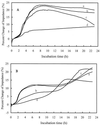Rapid differentiation of fermentative from nonfermentative gram-negative bacilli in positive blood cultures by an impedance method
- PMID: 11015369
- PMCID: PMC87442
- DOI: 10.1128/JCM.38.10.3589-3594.2000
Rapid differentiation of fermentative from nonfermentative gram-negative bacilli in positive blood cultures by an impedance method
Abstract
Rapid differentiation of fermentative gram-negative bacilli (fermenters) from nonfermentative gram-negative bacilli (nonfermenters) in positive blood cultures may help physicians to narrow the choice of appropriate antibiotics for empiric treatment. An impedance method for direct differentiation of fermenters from nonfermenters was investigated. The bacterial suspensions (or positive culture broths containing gram-negative bacteria) were inoculated into the module wells of a Bactometer (bioMérieux, Inc., Hazelwood, Mo.) containing 1 ml of Muller-Hinton broth. The inoculated modules were incubated at 35 degrees C, and the change in impedance in each well was continuously monitored. The amount of time required to cause a series of significant deviations from baseline impedance values was defined as the detection time (DT). The percent change of impedance was defined as the change of impedance at the time interval from DT to DT plus 1 h. After testing 857 strains of pure cultures (586 strains of fermenters and 271 strains of nonfermenters), a breakpoint (2.98%) of impedance change was obtained by discriminant analysis. Strains displaying impedance changes of greater than 2.98% were classified as fermenters; the others were classified as nonfermenters. By using this breakpoint, 98.6% (340 of 345) of positive blood cultures containing fermenters and 98% (98 of 100) of positive blood cultures containing nonfermenters were correctly classified. The impedance method was simple, and the results were normally available within 2 to 4 h after direct inoculation of positive blood culture broths.
Figures



Similar articles
-
Direct antimicrobial susceptibility testing of gram-negative bacilli in blood cultures by an electrochemical method.J Clin Microbiol. 1998 Oct;36(10):2882-6. doi: 10.1128/JCM.36.10.2882-2886.1998. J Clin Microbiol. 1998. PMID: 9738038 Free PMC article.
-
Evaluation of a new identification system, Crystal Enteric/Non-Fermenter, for gram-negative bacilli.J Clin Microbiol. 1995 Apr;33(4):845-9. doi: 10.1128/jcm.33.4.845-849.1995. J Clin Microbiol. 1995. PMID: 7790449 Free PMC article. Clinical Trial.
-
Evaluation of PASCO MIC-ID system for identifying gram-negative bacilli.J Clin Microbiol. 1987 Dec;25(12):2363-6. doi: 10.1128/jcm.25.12.2363-2366.1987. J Clin Microbiol. 1987. PMID: 3323230 Free PMC article.
-
The identification of gram-negative, nonfermentative bacteria from water: problems and alternative approaches to identification.Adv Appl Microbiol. 1986;31:293-365. doi: 10.1016/s0065-2164(08)70446-5. Adv Appl Microbiol. 1986. PMID: 2424280 Review. No abstract available.
-
Applications of cellular fatty acid analysis.Clin Microbiol Rev. 1991 Oct;4(4):422-38. doi: 10.1128/CMR.4.4.422. Clin Microbiol Rev. 1991. PMID: 1747860 Free PMC article. Review.
Cited by
-
Rapid clinical bacteriology and its future impact.Ann Lab Med. 2013 Jan;33(1):14-27. doi: 10.3343/alm.2013.33.1.14. Epub 2012 Dec 17. Ann Lab Med. 2013. PMID: 23301218 Free PMC article. Review.
-
The Role of Automation for Early Diagnosis of Non-fermenter Superbugs in Critically Ill Septicemic Hospitalized Patients.Cureus. 2023 Jul 6;15(7):e41484. doi: 10.7759/cureus.41484. eCollection 2023 Jul. Cureus. 2023. PMID: 37551224 Free PMC article.
-
Stenotrophomonas maltophilia as an Emerging Ubiquitous Pathogen: Looking Beyond Contemporary Antibiotic Therapy.Front Microbiol. 2017 Nov 30;8:2276. doi: 10.3389/fmicb.2017.02276. eCollection 2017. Front Microbiol. 2017. PMID: 29250041 Free PMC article. Review.
References
-
- Appelbaum P C, Spangler S K, Tamarree T. Susceptibility of 310 nonfermentative gram-negative bacteria to azthreonam, carmonam, ciprofloxacin, ofloxacin and fleroxacin. Chemotherapy. 1988;34:40–45. - PubMed
-
- Appelbaum P C, Tamin J, Pankuch G A, Aber R C. Susceptibility of 324 nonfermentative gram-negative rods to 6 cephalosporins and azthreonam. Chemotherapy. 1983;29:337–344. - PubMed
-
- Bisbe J, Gatell J M, Puig J, Mallolas J, Martinez J A, Jimenez de Anta M T, Soriano E. Pseudomonas aeruginosa bacteremia: univariate and multivariate analyses of factors influencing the prognosis in 133 episodes. Rev Infect Dis. 1988;10:629–635. - PubMed
-
- Chang S C, Chen Y C, Luh K T, Hsieh W C. In vitro activities of antimicrobial agents, alone and in combination, against Acinetobacter baumannii isolated from blood. Diagn Microbiol Infect Dis. 1995;23:105–110. - PubMed
-
- Cisneros J M, Reyes M J, Pachon J, Becerril B, Caballero F J, Garcia-Garmendia J L, Ortiz C, Cobacho A R. Bacteremia due to Acinetobacter baumannii: epidemiology, clinical findings, and prognostic features. Clin Infect Dis. 1996;22:1026–1032. - PubMed
Publication types
MeSH terms
Substances
LinkOut - more resources
Full Text Sources
Other Literature Sources

